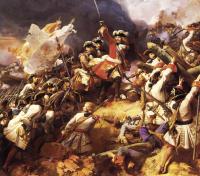Richard Cantillon —the father of economics
Published in 18th–19th - Century History, Early Modern History (1500–1700), Features, General, Issue 2 (March/April 2013), Volume 21
The Battle of Denain by Jean Alaux (1839)—the decisive battle in the War of the Spanish Succession, where the young Cantillon got his big break as assistant to British paymaster-general James Brydges from 1711.
Kerryman Richard Cantillon was born in the 1680s to a Hiberno-Norman landowning family from Ballyheigue. The family fought alongside James II, to whom they were related, during the Williamite War and were consequently dispossessed of their lands. Nevertheless, Cantillon’s landed gentry origins were to leave a lasting impression on his work, and his experiences in rural Ireland were to shine through in his seminal work, Essai sur la nature du commerce en général, in which the landlord plays a crucial decision-making role in economic production and consumption.
Origins of economic science
Cantillon’s scientific approach, logical-deductive theorising and positivist (value-free) concern with establishing cause and effect in his Essai truly marked the origins of economic theory. Joseph Schumpeter described it as ‘the first systematic penetration of the field of economics’. William Stanley Jevons dubbed Cantillon’s work ‘the cradle of political economy’. Carl Menger had a copy in his library. The Essai also strongly influenced Nobel laureate Friedrich Hayek, as well as Malthus, Quesnay, Turgot and Say; Cantillon is one of few influences cited in Adam Smith’s The wealth of nations.
His Essai made valuable contributions to the Theory of Uncertainty and the development of economic geography. He also contributed to the fields of monetary theory, the Theory of Value, behavioural economics, demography and methodological individualism. Cantillon was the first to formally articulate the concept of ‘opportunity cost’, the very foundation of economic theory.
Ominously, given Ireland’s current difficulties, Cantillon also presented a theory of economic cycles that revolve around price inflation and the collapse of indigenous industry. In his theory, increased money supply helps trigger an economic boom. If the money is spent too quickly, however, problems emerge—prices increase and the positive impact of the money soon dissipates. Indigenous industry shrinks and the country succumbs to a balance-of-payments problem. Here he suggested that, rather than adopting a ‘When-I-have-it-I spend-it’ attitude, the money should instead be saved by the state for use in times of need.
International man of mystery
Although little is known about his early life, Cantillon moved to France in his early to mid-twenties. By 1711 he was in Spain in the employment of HM paymaster-general, James Brydges, helping to finance the British forces abroad during the War of the Spanish Succession. It was in Spain that Cantillon’s economic theorising began in earnest. His prophetic insights about the role of the entrepreneur were a reflection of this period, during which he learned the basics of banking and finance and developed his accounting and negotiating skills.
Cantillon remained in Spain until 1714, cultivating business and political connections, before returning to France to work for his second cousin (also named Richard) in the Paris branch of the family bank, whose clientele comprised many expatriate Jacobites, including the Stuart court in exile. One of the connections cultivated was Matthew Decker, a prominent banker and director of the British East India Company. When, in 1716, Cantillon’s cousin was forced to declare bankruptcy amidst the widespread economic instability that characterised the aftermath of the War of the Spanish Succession, Decker helped the younger Cantillon to buy out the bank. (There is reasonable suspicion that the younger Cantillon was already its de facto owner and was merely using his cousin as a ‘straw man’ for the bank’s creditors.)
Friends in high places
Thanks in large part to the financial backing of Brydges and Decker, Cantillon quickly became an established banker. A man of great intellect, he was exceptionally well travelled for his day, spoke several languages and knew many of the greatest figures of his age, including Montesquieu, the 1st Viscount Bolingbroke and Voltaire. With such prestigious contacts Cantillon was able to specialise in money transfers between Paris and London to great personal success, and while the ethics of his financial dealings were often questioned, his influential connections ensured that the business proved very profitable.
The key episode in Cantillon’s life came through his involvement with the Scottish mercantilist, professional gambler and convicted murderer John Law, whose programme of economic and financial innovations inflated and then almost obliterated the economy of France during the ‘Mississippi madness’ of 1719–20. In the early 1700s the excesses of King Louis XIV left Bourbon France suffering a severe debt overhang problem. Based on the monetary theory of William Potter in his book The key of wealth (1650), Law believed that he could rid France of her national debt by developing a new financial system based on the promise of riches from her new American colony of La Louisiane.
Potter’s theory suggested that increases in the money supply would encourage the employment of previously unused land and labour, therefore leading to higher productivity. In the politically uncertain environment that characterised France after the War of the Spanish Succession—defeated and on the brink of her third national bankruptcy in less than a century—Law, whom the French had previously suspected of being a British spy, persuaded France’s desperate Regency government to grant him permission to found a national Banque Générale, in effect France’s first central bank. Law convinced the regent, Philippe d’Orléans, that he could use fiat money printed by the bank to finance the development of France’s New World territories, suggesting that with the regency’s monopoly rights to the profits his Mississippi Company could easily pay off the three billion livres of French public debt.

Portrait of Louis XIV of France by the French baroque painter Hyacinthe Rigaud (1701). The financial excesses of Louis XIV created the severe debt overhang problem for France that forced its regency government to take a gamble on John Law’s ‘Scheme’.
Bubble trouble
Exaggerated claims of wealth in Louisiana soon gave rise, however, to speculative mania. Share prices became grossly overvalued. Indeed, it was in these heady days that the word millionaire was first coined. The viability of Law’s scheme was contingent on asset prices remaining high. Unfortunately, his ‘system’ was shortly to come undone, when the failure of French Louisiana to live up to these over-hyped expectations meant that Law’s increase of the money supply was not matched by real economic growth.
As with Anglo-Irish Bank in more recent times, this led Law to devise a share support mechanism that allowed speculators to buy shares in his Compagnie using low-interest loans from Law’s own bank. Just like the property sector in ‘Celtic Tiger’ Ireland—where financial ‘innovation’ helped to create enormous amounts of debt and derivatives based on exaggerated property prices—Law’s scheme saw share prices rocket. The unprecedented rate of inflation unnerved shareholders. Many started to cash in and get out. Apprehensive, Law attempted to ensure that his bubble had a ‘soft landing’. But bubbles never end with soft landings—they burst!
The bursting of the Mississippi bubble was spectacular. The value of Compagnie shares collapsed by almost 90% and France was bankrupted. The government was forced to step in and bail out investment banks and failed corporations. A vehicle called le Visa—a ‘bad bank’ structure similar to Ireland’s current NAMA system—was established to pump liquidity back into the market, but the decimation from Law’s scheme took generations to repair. There is even an argument to suggest that resentment of the bailout helped to precipitate the French Revolution.
Crucially for Cantillon, he saw through Law’s inflationist theories. Understanding their fatal flaw (the Quantity Theory of Money, i.e. the tendency to think of currency in nominal rather than real value terms), and not being one to pass up an opportunity, he was thus one of the very few to exit Law’s bubble with his fortune intact. Indeed, the irony of Law’s scheme, from a modern Irish perspective, is that the Irishman was one of the few to profit from the bubble.
Get out while you can
Seeing Law’s scheme as unsound, Cantillon had bought shares early and sold at a large profit. Then, with the collapse of the Mississippi bubble, he added to his initial profit by collecting on the Mississippi Company’s bond debt at high rates of interest. Unfortunately, those who had lost out when the bubble burst (including James Brydges) blamed Cantillon for their misfortune. Accused of being a glorified con man, Cantillon was rebuked for the now illegal practice of market manipulation—purchasing stocks when their prices were low before recommending them to his associates and then selling his shares as their values soared thanks to the increased demand.
The result was that, from then until his death fourteen years later, Cantillon was involved in numerous lawsuits, including at least one with John Law. He was also the victim of several murder plots, was himself accused of attempted murder and was twice briefly imprisoned for fraud (albeit for only a few hours in total). He eventually fled France in frustration, travelling widely throughout Europe before finally settling in London in 1733.
Serendipitously, his involvement in Law’s speculative bubble was to prove an invaluable influence on Cantillon’s later work, because it was in the wake of Law’s financial devastation that Cantillon would write his seminal Essai. Written more than four decades before Adam Smith’s The wealth of nations (1776), the Essai broke away from the traditional mercantilist assumptions of the day, thus making a transformative contribution to our understanding of economics. A critique of the policies and financial innovations of John Law, the Essai remains Cantillon’s only surviving publication on economics. There is good reason to suspect that Cantillon was not overly interested in its academic merit but instead developed his economic theories primarily to support his legal defence against charges of usury.

John Law—Cantillon’s Essai is a critique of Law’s policies and financial innovations.
A series of unfortunate events
Tragically, despite being a significant influence on the early development of the Physiocrat and Classical schools of economic thought, Cantillon’s Essai was largely forgotten until the late nineteenth century, when it was rediscovered by the celebrated British economist William Stanley Jevons. A series of mishaps, beginning with a sloppy English translation, were to result in the Essai being poorly received outside France. Added to this, the first English publisher somehow inverted the names of the book’s author and its original French publisher in his initial publication. The date of publication was also confused, so that the work was for a time assumed to have copied the theories of the Scottish economist David Hume, when in fact Hume’s ideas were anticipated by Cantillon.
In 1734, a year after arriving in London, Cantillon’s home on Albemarle Street was mysteriously burned to the ground. Many of his papers were destroyed and it is generally assumed that he died in the fire. While the fire’s cause is unclear, the most widely accepted theory is that Cantillon was murdered. It seems that his profiting from others’ misfortune finally caught up with the banker. A contemporary investigation concluded that Cantillon was stabbed to death, probably by his recently dismissed French cook, Joseph Denier. Though three of Denier’s former co-workers were charged with murder, each was acquitted. Denier himself fled to Holland and was never tried.
Intriguingly, Antoin Murphy, the foremost expert on Cantillon’s life, suggests that he may have staged his own death to escape harassment from his debtors. Murphy surmises that the body discovered in Cantillon’s house was not that of the Irishman, but that he instead used the fire as ‘a cover to depart from European society’. A mysterious Chevalier de Louvigny, in possession of several of Cantillon’s personal documents, turned up in Dutch Surinam six months after the latter’s supposed demise.
Whatever happened, Cantillon’s formative role in the development of economic science is unquestioned. Though not the first to ponder economic matters, he was the first to do so in a systematic manner. A gifted independent observer who enjoyed an unsurpassed vantage over one of the most significant events in economic and financial history, his Essai became the cornerstone on which all subsequent economic analysis has been built. He was truly, as Murray Rothbard dubbed him, the ‘founding father of economics’, a genuine Irish entrepreneur. HI
Séamus Nevin is Commissioning Editor at the International Policy Network think-tank.
Further reading
H. Higgs, Life and work of Richard Cantillon (London, 1931).
W.S. Jevons, Richard Cantillon and the nationality of political economy (London, 1881).
A.E. Murphy, Richard Cantillon: entrepreneur and economist (Oxford, 1986).
















